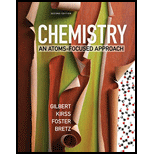
To find:
a) The sign of
b)
c) If the calculations support the prediction for the sign of
Answer to Problem 12.80QA
Solution:
a) The sign of
b)
c) The calculations support the predictions.
Explanation of Solution
1) Formula:
Here
2) Concept:
Entropy is a state function of the chemical and physical state of a system and not the pathway followed to reach that state. Therefore, the change in entropy is calculated by the entropy of final and initial state of reaction. The formula is given above. In other words, entropy is the measure of randomness or disorder of the system. Therefore, the order of entropy of three phases of substance is
3) Given information:
| Substance | ||||||
4) Calculations:
Calculation for
In this reaction, randomness or entropy change goes on increase from solid to aqueous phase (product to reactant). But as the
Calculation for
In this reaction, randomness increases from product to reactants. Therefore the change in entropy is negative. Thus, this is a non-spontaneous reaction
Conclusion:
a. The sign of
b.
c. Calculations do support the prediction.
Want to see more full solutions like this?
Chapter 12 Solutions
Chemistry: An Atoms-Focused Approach (Second Edition)
 ChemistryChemistryISBN:9781305957404Author:Steven S. Zumdahl, Susan A. Zumdahl, Donald J. DeCostePublisher:Cengage Learning
ChemistryChemistryISBN:9781305957404Author:Steven S. Zumdahl, Susan A. Zumdahl, Donald J. DeCostePublisher:Cengage Learning ChemistryChemistryISBN:9781259911156Author:Raymond Chang Dr., Jason Overby ProfessorPublisher:McGraw-Hill Education
ChemistryChemistryISBN:9781259911156Author:Raymond Chang Dr., Jason Overby ProfessorPublisher:McGraw-Hill Education Principles of Instrumental AnalysisChemistryISBN:9781305577213Author:Douglas A. Skoog, F. James Holler, Stanley R. CrouchPublisher:Cengage Learning
Principles of Instrumental AnalysisChemistryISBN:9781305577213Author:Douglas A. Skoog, F. James Holler, Stanley R. CrouchPublisher:Cengage Learning Organic ChemistryChemistryISBN:9780078021558Author:Janice Gorzynski Smith Dr.Publisher:McGraw-Hill Education
Organic ChemistryChemistryISBN:9780078021558Author:Janice Gorzynski Smith Dr.Publisher:McGraw-Hill Education Chemistry: Principles and ReactionsChemistryISBN:9781305079373Author:William L. Masterton, Cecile N. HurleyPublisher:Cengage Learning
Chemistry: Principles and ReactionsChemistryISBN:9781305079373Author:William L. Masterton, Cecile N. HurleyPublisher:Cengage Learning Elementary Principles of Chemical Processes, Bind...ChemistryISBN:9781118431221Author:Richard M. Felder, Ronald W. Rousseau, Lisa G. BullardPublisher:WILEY
Elementary Principles of Chemical Processes, Bind...ChemistryISBN:9781118431221Author:Richard M. Felder, Ronald W. Rousseau, Lisa G. BullardPublisher:WILEY





